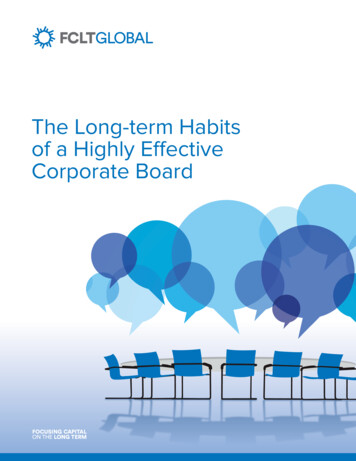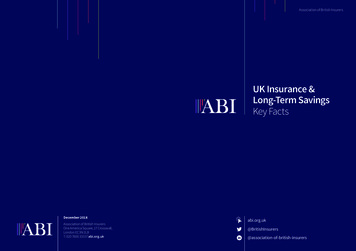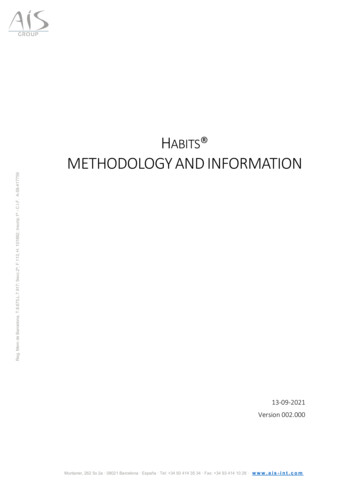
Transcription
The Long-term Habitsof a Highly EffectiveCorporate Board
MARCH 2019FCLTGlobal is dedicated to rebalancing investment and business decision-makingtowards the long-term objectives of funding economic growth and creating future savings.FCLTGlobal is a not-for-profit dedicated todeveloping practical tools and approaches thatencourage long-term behaviors in business andinvestment decision-making. It takes an activeand market-based approach to achieve its goals.By conducting research and convening businessleaders, FCLTGlobal develops tools and generatesawareness of ways in which a longer-term focusFOUNDERSMEMBERS2 The Long-term Habits of a Highly Effective Corporate Boardcan increase innovation, and create value.FCLTGlobal was founded in 2016 by BlackRock,Canada Pension Plan Investment Board, The DowChemical Company, McKinsey & Company, andTata Sons out of the Focusing Capital on the LongTerm initiative. Its membership encompasses assetowners, asset managers and corporations fromaround the world.
Table of ContentsTABLE OF CONTENTSAUTHORSAriel Fromer Babcock4Executive SummaryLead Author5The Long-term Habits of a Highly EffectiveCorporate BoardAllen He6Spend More Time on StrategyVictoria Tellez8Ensure That Directors Have a Stake inLong-term SuccessSarah Keohane Williamson10Communicate Directly with Long-termShareholders11Ensure a Diverse Board13Conclusion15Acknowledgements16Endnotes19Is My Board Cultivating the Long-term Habitsof a Highly Effective Corporate Board?Evan HorowitzSEE SELF-ASSESSMENT CHECKLIST ON PAGE 19This document benefited from the insight andadvice of FCLTGlobal’s Members and otherexperts. We are grateful for all the input we havereceived, but the final document is our own andthe views expressed do not necessarily representthe views of FCLTGlobal’s Members or others.The information in this article is true and accurateto the best of FCLTGlobal’s knowledge. Allrecommendations are made without guarantee onthe part of FCLTGlobal. Reliance upon informationin this material is at the sole discretion of thereader; FCLTGlobal disclaims any liability inconnection with the use of this article.The Long-term Habits of a Highly Effective Corporate Board 3
TheLong-termHabits of aExecutiveSummaryHighly Effective Corporate BoardIt’s hard to focus on long-term goals with so many pressing, market-driven demands for quickrewards and quarterly projections. But companies that prioritize long-term needs tend tooutperform peers that bow to short-term market pressure, whether you look at revenue growth,profitability, or job creation.Corporate boards are vital in helping companiesmaintain a longer-term focus even while executingon shorter-term priorities. Around the world, thetypical board member has actually served longerthan the typical CEO—7.7 years compared to6.3—which gives boards a wide perspective on acompany’s current and future path.1 And board'sunique stature, sitting atop the organization, allowsthem to shape corporate culture through a mix ofencouragement, skepticism, and guidance.However, boards are not immune to short-termthinking. And even those directors most committedto long-term thinking get a lot of misleading andunproven advice. Despite a substantial body ofpublished work on board best practices and goodgovernance, 47 percent of corporate executivesreport that their boards are actually an unexpectedsource of short-term pressure and an impediment tolong-term strategic thinking.2 Directors themselvesacknowledge they could do more to help thesituation: one survey found that 60 percent ofdirectors agreed they have a responsibility to tackleshort-termism at their organizations.3This paper, which crystallizes the collective knowledgeand experience of FCLTGlobal’s Members and othersubject-matter experts, offers two novel contributions:(1) it reassesses some of the common counselgiven to directors on issues like overboarding andCEO–chair duality, where the evidence for longterm value creation is weak or contradictory; and(2) it identifies the following proven steps boardscan take if they aim to be long-term leaders with afarsighted vision of corporate success.4 The Long-term Habits of a Highly Effective Corporate BoardSpend more time on strategy. Strategic counselis an area where board members can addtremendous value, with insight drawn fromreal-world experience and enriched by regularattention to the company’s business model, risks,and value-creation proposition.Ensure that directors have a stake in long-termsuccess. Encouraging board members to purchaseand hold company stock through and beyond theirtenure helps align their interests with those oflong-term investors.Communicate directly with long-term shareholders.Although they sit outside the organization, longterm shareholders have a real interest in durable,corporate success. Listening to their viewpoint canbroaden the perspective of board members, whilealso turning long-term investors into allies.Ensure a diverse board. Differing perspectivesamong board members can unearth newapproaches and opportunities. One way toensure that diverse views are heard is to build aboard that includes people from a wide range ofdemographic backgrounds.Board members looking to guide their companiestoward a prosperous, long-term future can usethese findings as a roadmap. And just as important,investors looking to identify companies with along-term vision can use these results to gaugewhich boards are well positioned to help avoidshort-term shoals.
The long-term habitsof a highly effectivecorporate boardResearch from FCLTGlobal and beyond has shownthat long-term companies outperform on financialmetrics, including revenues, profitability, and stockprice. They also fare better on several nonfinancialmetrics, including job creation. As a recent studyof large public companies in the United Statesfound, from 2001 to 2014 long-term companiescumulatively grew their revenues 47 percent moreon average than their shorter-term peers, with lessvolatility. During the same period, these long-termcompanies similarly outperformed on measuresof economic profit, cumulatively besting peers by80 percent, with earnings growth that was also 35percent higher.4Companies seeking the performance advantagesthat come from long-term thinking should have aready partner in their corporate board.Not all well-meaning proposals have reallong-term impact.Several of the most widely prescribed remediesfor ailing boards don’t seem to improvelong-term company performance, accordingto FCLTGlobal’s review of the evidence. Weused global data to see which board actionswere actually correlated with long-term valuecreation and found no evidence that these threemeaningfully affect returns: overboarding,CEO-chair duality, and tenure.Arguably among a company’s biggest untappedstrategic assets, a well-functioning long-term boardof directors wields the power to meaningfullyinfluence the purpose, culture, and direction of anorganization, setting an appropriate long-term tonefor both corporate management and shareholders,as well as ultimately driving long-term value creationby insulating management and the companyas a whole from short-term market pressures.Often, however, boards unwittingly push in theother direction, increasing the impact of shortterm pressure rather than blunting it. Corporatemanagement teams frequently cite their ownboard as a primary source of short-term pressureon their organization.5 Three of every four directorsconcede that short-term pressure has compromisedmanagement’s focus on strategic goals.6Given the breadth of board responsibilities, it’sunderstandable that short-term pressures candistract from longer-term needs. Compliance issuesand regulatory burdens are a constant matter forattention, as mistakes can leave the companyvulnerable to litigation. What’s more, activistinvestors are always looking for missteps and otheropenings to press their priorities. Not to mentionthe ever-present possibility of macroeconomicdisruption and financial market volatility, which canupend even the best-laid long-term plans.But directors needn’t approach this tension asa trade-off. It is possible to address short-termdemands while still working to improve long-termperformance. In fact, building a strong board witha committed long-term focus can help insulatecompanies from some of those short-termconcerns. For instance, boards with an establishedrecord of long-term leadership will find moreallies in a fight against activist shareholders andhave more credibility when claiming that a dip inearnings is likely to be short lived.Building on original research, conversations withkey stakeholders, and a review of existing studies,FCLTGlobal has identified a number of actionsdirectors can take to enhance credibility andmaximize their impact on the long-term needs ofthe companies they oversee.The Long-term Habits of a Highly Effective Corporate Board 5
The Long-term Habits of aHighly Effective Corporate BoardSPEND MORE TIME ON STRATEGYBoards with a demonstrated, long-term impact spendnearly twice as much time on high-level issues likestrategy, business model, risks, and the company’svalue-creation proposition, according to researchfrom McKinsey.7 That link between long-term successand strategic focus is well demonstrated by theNordic countries, where companies consistentlyoutperform over long horizons and wherecorporate boards play a particularly robust role,driving strategic decision-making.8Directors agree they need to do better, with 67percent of directors reporting the need to improvetheir contribution to the development of strategy.9But the hurdles can seem high. Regulatoryand compliance-related tasks often consumesignificant board attention and eat up large partsof their agendas. A few more cynical experts wespoke with also pointed out that there is really noupside for the board in spending more time onstrategy. These people were quick to note thatthe CEO typically gets the credit if the company’sstrategy succeeds.But many shareholders want boards to be moreinvolved in strategy work, a sentiment capturedby John Vaske, head, Americas, at Singapore’sTemasek: “Boards have to be really immersed instrategy; it can’t be at a superficial level. Directorsthat are long-term have the time and inclination todig into those strategy-related questions—that’swhere value-creation happens.”Boards that are serious about optimizing the timethey spend on strategy can focus on some of thefollowing areas.6 The Long-term Habits of a Highly Effective Corporate BoardOverboarding doesn't hamper long-termperformance.The possibility that some directors sit ontoo many boards is a live concern for proxyadvisors and some regulators. Glass Lewis’s2019 voting guidelines state: “In our view,an overcommitted director can pose amaterial risk to a company’s shareholders,particularly during periods of crisis.”10 Butthe academic literature is not so conclusive,11and FCLTGlobal’s own analysis found nocorrelation between overboarding andlong-term results. This is, in part, becauseoverboarding is extremely rare. We foundthat fewer than 5 percent of all MSCI ACWIdirectors serve on three or more publiccompany boards, and the median number ofexternal public company boards MSCI ACWIdirectors serve on is 1.1. Given this dearth ofexamples, overboarding seems more likea theoretical quandary than a real-worldconcern today—and not a major source ofpressure on board time.Meeting materials. Half of board directors reportthat the agenda alone is a big reason they spendtoo little time discussing strategy.12 Too often,compliance-related issues are frontloaded or givendisproportionate time, which detracts from meatierdiscussion. INSEAD professor Stanislav Shekshniaexplained in a recent Harvard Business Reviewarticle that good board chairs are extremely carefulwith their meeting agendas.13 By ensuring theagenda includes no more than six items and theseitems are only topics that are “strategic, material,ripe for decision, and something only the board canhandle,” good board chairs ensure that time is putto the best possible use. Barclays’ chairman, John
McFarlane, emphasizes the importance of settingsound priorities: “I like to have the most importantmatters for discussion first on the agenda, followedby matters for approval, so that time is not restrictedon these items.” Boards that are thoughtful withmeeting materials—by forcing concise documents,providing executive summaries, and limitingmanagement presentation time to allow forenough discussion and Q&A—create extra timein their agendas for more meaningful work onstrategy-related questions.14Committee delegation. Full-board time at successfullong-term companies is precious, and delegatingto committees is one way to ensure that multipleissues get addressed in a rigorous way. Globalbanking and financial services powerhouse HSBCestimates that their directors spend three-quartersof their time on committee work, an approachHSBC believes allows for more candid, small-groupconversations. The considered outcome of suchconversations can then be brought forward for fullboard review. Interestingly, this in-depth focus atthe committee level was achieved despite shrinkingHSBC’s board to 14 members from the prior 17 (afterbeing as large as 21 members as recently as 2015).15Preparation. More preparation means less timegetting up to speed during the meeting and moretime for substantive discussion. Some long-termboards also assign mandatory “homework,” in theform of materials to pre-read. Netflix shares anonline live memo in advance of board meetingsand invites comments and questions upfront.16 AsJoel Posters, head of Investment Stewardship andESG at Future Fund, puts it: “We’ve seen companieswho are successful at this limit the time spent onpresentations. Since everyone is presumed to haveread materials in preparation, that leaves more timeto devote to debate and decision-making.”Follow-up. High-level meeting minutes that includekey decisions, conclusions, and resolutions canmake debates feel settled and ensure that itemsdon’t resurface later for repeat discussion. Thelevel of detail needn’t be too granular—no needfor a complete rundown of who said what andwhen—provided the key points and takeaways areclearly summarized. A good company secretaryis invaluable in this respect. As Michelle Edkins,managing director and global head of InvestmentStewardship at BlackRock, suggests, “A goodsecretary keeps the board on track with theiragendas, documents key progress, and ensuresregular follow-up on key items to make sure theboard’s decisions are heard and implementedfurther down the organization.”Time outside of meetings. Not all strategic workhappens during the board meeting. Site visits,competitor product comparisons, ongoingconversations with management and otheremployees, discussions with external stakeholderslike suppliers or customers, and a continuousreview of industry analysis can all enrich thestrategic insights of board members. McKinsey &Company’s Senior Partner Emeritus and boardpractice expert Conor Kehoe has emphasized theimportance of this broader strategy immersion,noting that “boards who spend more time onstrategy achieve this by spending more timeon their board duties overall. This extra timeis spent, in the main, outside formal board andcommittee meetings.”The Long-term Habits of a Highly Effective Corporate Board 7
The Long-term Habits of aHighly Effective Corporate BoardFCLTGlobal’s Time Visualization MeterTo see how strategy focused your board really is—and where you may be able to trim fat from youragenda—FCLTGlobal has developed a graphicaltool showing how long-term boards allocate theirtime and how you stack up against your industrypeers and successful long-term boards. That way,you can see whether there are opportunities toimprove your agenda and intensify your focus onthe long term.ENSURE THAT DIRECTORS HAVE A STAKE INLONG-TERM SUCCESSBoard members who make meaningful longterm financial investments in the companies theyoversee have greater incentive to focus on longterm strategic choices. Having “skin in the game”binds their individual portfolios to the fate of thecompanies they serve.The virtue of this “directors as owners” model isclearly exemplified by companies with a significantanchor or family shareholder, as these kinds ofowners are strongly motivated to pass a thrivingbusiness to their children and grandchildren.17Lady Lynn Forester de Rothschild, chair of E.L.Rothschild and director of The Estée LauderCompanies, captures that multigenerationalperspective: “They [family-run businesses] are8 The Long-term Habits of a Highly Effective Corporate Boardused to planning in terms of generations. Thisgenerational planning is the ultimate long-termmanagement horizon. We need to get moretraditional directors to start to think of themselvesthat way and behave like family owners.”Encouraging—or even mandating—that directors buyand hold company stock for extended periods givesthem a version of this multigenerational, longer-termview. And there’s strong evidence linking directorstock ownership to long-term value creation and firmoutperformance. One 1998 study of 1,700 US publiccompanies found that larger dollar-value investmentsby outside directors was linked to (1) better companyperformance, as measured by three-year growthin operating income, three-year growth in sales,stock returns, and return on equity; and (2) a greaterlikelihood that poorly performing companies wouldsee disciplinary-type CEO turnover.18 A follow-upstudy from 2011 confirmed that the dollar value ofdirector stock ownership is positively related to firmoperating performance.19 And the recently publishedupdate to the “Commonsense Principles for CorporateGovernance” agrees: “Companies should considerrequiring directors to retain a significant portion oftheir equity compensation for the duration of theirtenure to further directors’ economic alignmentwith the long-term performance of the company.”20It’s vital to emphasize the “hold” part of thisequation. If board members are free to sell orhedge company stock at any moment, it couldactually stoke short-term behavior by lettingboards benefit from unsustainable stock pricemovements. It is common today to have retentionrequirements for stock owned by board members;however, 55 percent of retention requirementsmandate a holding period that lasts only until thestock ownership guidelines are met.21 In addition,directors are free to sell stock in excess of the
mandated minimum ownership and often do.Indeed, this fear of introducing an excessivelyshort-term perspective to the boardroom hasinduced some nations, like the United Kingdom,to go so far as to consider directors who ownsignificant amounts of a company’s stock (orwho represent a significant shareholder) to nolonger qualify as independent, reclassifying thesedirectors as insiders.22A relatively straightforward solution with just twocriteria is emerging. First, companies would requiredirectors to accumulate—in the open market, overa period of years determined by the company—aproportion or fixed minimum multiple of their cashcompensation in stock of the company they serve.Second, directors would be prohibited from sellingor hedging all accumulated stock during and fora period of years (again to be determined by thecompany) beyond their term of service.Because the stock is locked up (restricted fromsale), directors’ experience as shareholders willmirror the experience of long-term investors,limiting their attention to short-term changes instock valuation and volatility.The fact that the shares will be purchased, ratherthan granted, gives directors a heightened senseof ownership—rather like the difference betweenbetting with your own money and using house chips.There are other advantages to this requirement thatthe shares be purchased directly: it makes the planmore palatable to shareholders concerned withexcessive director compensation via granted shares,and it ensures the approach works in jurisdictionswith regulations against granting shares to directors.As a further step, this same restriction on sellingstock could be applied more broadly, withcompanies barring directors from selling anycompany stock they may have acquired over theyears beyond just the shares they are required topurchase as part of their board service. Doing soSome companies have already embraced a“buy and hold” mandate for board members.As a director with one Fortune 500 companywe spoke with observed,“What kind of signal does it send when thevery people tasked with shepherding a firmon its path to successful growth sell theirshares? As a market participant how couldyou possibly interpret that action in a positivelight? It seems like giving up on our ownability to create future long-term value.”would further align board interests, shareholderinterests, and long-term corporate goals, curtailingany incentives to seek personal gains by timingcorporate ups and downs.Improved disclosure could also help amplify theimpact of a buy-and-hold approach, ensuring notonly that board members’ ownership interests arealigned with those of long-term shareholders’ viastock ownership but also that shareholders knowand can fully appreciate the depth of the board’slong-term commitment by perusing information aboutthe stock purchases, holdings, and sales by directors.There are still some risks to this approach,however. Perhaps the biggest is that a mandatorystock purchase program could narrow the poolof potential board members, weeding out those(younger and often more diverse) candidateswho can’t afford to buy large holdings in thecompany, as well as retirees who may need moreliquidity. Wachtell, Lipton, Rosen & Katz partnerSabastian Niles expressed this concern succinctly:“Imposing a requirement on all directors to buystock out of their personal wealth to satisfy desire forbetter shareholder alignment could affect directorsupply, skewing it to older, wealthier candidates.No one wants to go back to overly narrow poolsfor directors or creating disincentives to serve.”However, in a carefully calibrated plan, the size ofThe Long-term Habits of a Highly Effective Corporate Board 9
The Long-term Habits of aHighly Effective Corporate Boardthe stock purchase requirement can be linked todirector compensation levels, which should makeit more affordable for all involved.COMMUNICATE DIRECTLY WITHLONG-TERM SHAREHOLDERSBoard members who engage with long-termshareholders can expand the board’s understandingof how their company is perceived by the market,which is invaluable for strategic debates anddecisions. According to Sarah Teslik, of strategiccommunications firm Joele Frank, “Long-termshareholders are like consultants, but free—shareholders have a massive financial stake intheir advice being accurate and a big motivationto share that information, but few ask for that inputoften enough. Smart long-term boards recognizeand avail themselves of this valuable resource.”Building relationships with key investors can also helpestablish mutual trust, which becomes particularlyvaluable when the company finds itself embroiledin a proxy battle, hostile takeover, or activist attack.Temasek’s Vaske emphasizes this point: “Boardsin crisis don’t seem to ever know anything aboutshareholders’ mind-sets: they constantly seem to besurprised in a proxy battle. Directors need an in-depthperspective on what shareholder constituencies needand want, and that has to happen before you have aproblem—engagement is the only way you get there.”Consider Unilever, which was able to beat back anunsolicited takeover thanks in part to the fact that 70percent of its shareholders are long-term investorswho have held their stock for more than seven years.23Some companies have embraced the chance topursue a more direct dialogue with shareholders.In their most recent proxy season review, EY founda big jump in the number of S&P 500 companiessaying their directors had engaged with investorsover the prior year, from 10 percent in 2015 to10 The Long-term Habits of a Highly Effective Corporate Board25 percent in 2018.24 A much larger number ofdirectors recognize the power of talking withinvestors. In PwC’s 2017 survey, 77 percent ofdirectors agreed that direct engagement impactsproxy voting (vs. just 59 percent in 2016).25 Andwhile US-listed companies remain slower toembrace an open dialogue with shareholders,it is already common practice in WesternEurope for nonexecutive directors to meet withshareholders to discuss strategy, governance,executive compensation, risk, and other matterswithin the board’s purview.26 Many managementteams remain wary of face-to-face discussionsbetween directors and shareholders—for severalreasons. For one thing, directors may lack theCompanies can still be long term when theCEO is also board chair.On this issue, some regulators and activistshareholders seem to have gotten ahead of theevidence. The United Kingdom, for instance,has a regulation stating that the roles of chairand CEO should not be exercised by the sameindividual.27 Meanwhile, studies span thegamut, with some showing that CEO-chairs aredetrimental to company performance,28 somesuggesting they’re beneficial,29 and othersshowing no effect.30 Our own analysis foundno statistically significant relationship betweenCEO–chair duality and long-term performance, asmeasured by return on invested capital (ROIC).And the board shouldn’t assume a CEO-chairengaging with shareholders means that otherdirectors are off the hook for communicatingdirectly with their long-term investors.depth of knowledge to answer all questions or thepreparation to stay on message. Many managersalso worry that such meetings could undermine
their authority to lead and manage the business.There are legal concerns as well. Most regulatorybodies have strict rules ensuring that all investorshave access to the same public information andthat large or well-placed shareholders don’t getadditional details. Meetings between boardsand shareholders risk exposing inappropriateinformation, so banning them seems like a simpleway to ensure there are no slips.With the right rules and preparation, however,disciplined boards can limit these risks and reapthe rewards that come from hearing directly fromlong-term shareholders. Here are some of theapproaches boards may consider.A concrete commitment to long-termshareholder success. Relatively brief additionsto the company’s code, corporate governanceguidelines, or charter can crystallize the board’slong-term commitment and serve as a defenseagainst pressure to maximize shareholder valuein the near term. As examples, HSBC’s termsof reference state: “The Board is collectivelyresponsible for the long-term success of theCompany and the delivery of sustainable valueto shareholders”; GSK’s guidelines state: “OurBoard is responsible for the long-term success ofGSK”; while Amazon’s note: “The Board’s primarypurpose is to build long-term shareowner value.”31Dedicated time for investor feedback. Rather thanreaching out in times of uncertainty or crisis, boardmembers attentive to the long term can makea habit of asking investors to help them identifyplaces where the company’s value propositionisn’t resonating. That could happen in a varietyof different ways, including at the annual generalmeeting or as part of a specially planned event,like an “engagement day” or an off-cycle “boardroadshow” with directors and major shareholders.Given that directors (and shareholders) are oftentime constrained, it’s worth considering alternateplatforms like a videoconference or online webinar.An understanding that directors are speaking onbehalf of the entire board. Even though directorsmay have individual meetings with investors, theyare not representing themselves as individualsin those meetings. Rather, long-term directorsengage with shareholders on behalf of the boardas a whole, offering a representative perspectiveof the full board’s thinking and viewpoint.Engagement on these terms is important inmaintaining unified messaging from the companyand helps alleviate fears of directors “going offscript” or running afoul of disclosure regulations.Open ears. Often, the most valuable informationcomes in the form of unexpected or unsolicitedfeedback, rather than in response to scripted orpredictable questions. Giving shareholders thechance to talk freely makes them more likely toexpress their particular viewpoint.A trusted company secretary. Effective secretariesare intimately familiar with the board’s thinking andare quite knowledgeable about the positions ofmajor shareholders. Working with investor relations,they can smooth collaboration with investors andhelp directors deliver a unified message.ENSURE A DIVERSE BOARDDiversity matters, both for board and companyperformance. A variety of studies havedemonstrated the value of multidimensionaldiversity—across ages, genders, ethnicity, andbeyond. One notable 2017 study found thatgreater board diversity was associated withreduced financial risk, larger R&D investments,and better operating performance.32 FCLTGlobal’sown research confirmed this assessment. Lookingat MSCI ACWI firms between 2010 and 2017 andusing a diversity metric that compasses bothage and gender, we found that the most diverseboards (top 20 percent) added 3.3 percentagepoints to ROIC, as compared to their least diversepeers (bottom 20 percent.)33The Long-term Habits of a Highly Effective Corporate Board 11
The Long-term Habits of aHighly Effective Corporate BoardGender diversity matters. When it comes to genderdiversity, in particular, FCLTGlobal’s analysis foundTenure is not a decisive factor inboard performance.Based on our analysis, tenure has nostatistically significant correlation with longterm value creation, though other researchershave arrived at different conclusions. One2018 study of US firms found a U-shapedrelationship between tenure and pe
The Long-term Habits of a Highly Effective Corporate Board 3 Table of Contents TABLE OF CONTENTS 4 Executive Summary 5 The Long-term Habits of a Highly Effective Corporate Board 6 Spend More Time on Strategy 8 Ensure That Directors Have a Stake in Long-term Success 10 Communicate Directly with Long-term Shareholders










